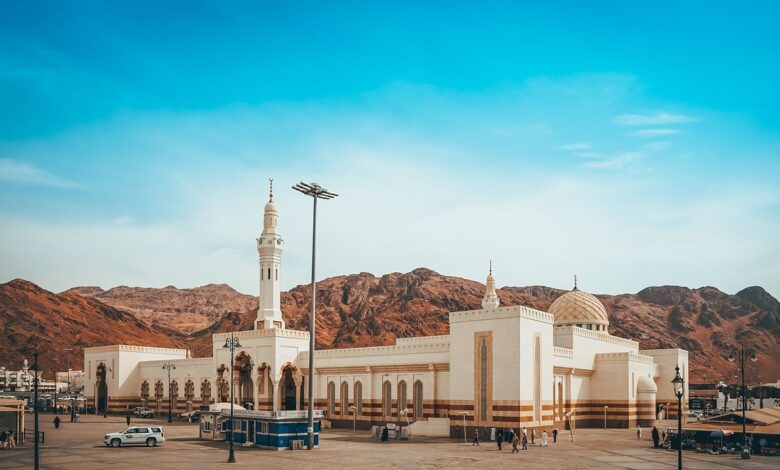Masjid Ghamama
Masjid Ghamama is just a few steps from Masjid Nabawi. This sacred mosque is tied to a moment of hope and mercy. It’s said that the Prophet Muhammad ﷺ once led the Salat al-Istisqa (prayer for rain) here during a time of drought in Madinah. As he completed the
prayer, clouds gathered and rain fell—hence the name “Ghamama,” which means “cloud” in Arabic.
🌧 Hadith:
ﺻَ ﱠﻠﻰ رَﺳُولُ ﱠِﷲ ﷺ ﺻَﻼَةَ اﻻﺳْﺗِﺳْﻘَﺎءِ ﺑِﺎﻟْﻣُﺻَ ﱠﻠﻰ، ﻓَدَﻋَﺎ وَاﺳْﺗَﻐْﻔَرَ، ﻓَﺄَﻧْﺷَﺄَ ﱠُﷲ ﺳَﺣَﺎﺑًﺎ وَأَﻣْطَرَ
“The Messenger of Allah ﷺ performed the prayer for rain (Salat al-Istisqa) and supplicated to Allah. Allah created clouds and it rained.”
(Sahih Muslim)
This mosque is a reminder of how faith and du‘a can bring about divine mercy. When visiting, many pilgrims sit quietly here and ask Allah for their own needs, just as the Prophet ﷺ did.
Masjid Jumuah
Masjid Jumuah marks a deeply spiritual event—the first Friday prayer led by the Prophet ﷺ in Madinah, shortly after his Hijrah (migration) from Makkah. This small mosque stands as a symbol of the beginning of Islamic community life in Madinah.
🕌 Hadith Event:
The Prophet ﷺ stopped in the area of Banu Salim ibn ‘Awf, and on Friday, he led Salat al-Jumuah with around 100 companions. It was a brief stop but held great importance.
📖 Scholars mention:
أَ ﱠولُ ﺟُﻣُﻌَﺔٍ ﺟُ ﱢﻣﻌَتْ ﺑَﻌْدَ ھِﺟْرَةِ رَﺳُولِ ﱠِﷲ ﷺ ﻛَﺎﻧَتْ ﻓِﻲ ﻣَﺳْﺟِدِ ﺑَﻧِﻲ ﺳَﺎﻟِمٍ
“The first Jumu‘ah after the migration of the Messenger of Allah ﷺ was held in the mosque of Banu Salim.”
(Ibn Sa’d, Tabaqat)
When you visit Masjid Jumuah, it’s like walking through the early pages of Islamic history, where unity, prayer, and brotherhood were just taking root. It’s a great place to reflect on your connection to the Ummah and the power of congregational worship.
Masjid Al-Ijabah
Masjid Al-Ijabah is a small but deeply spiritual mosque in Madinah where three special du‘as of the Prophet Muhammad ﷺ were accepted by Allah. The word “Ijabah” means acceptance, highlighting the significance of this site.
📍This mosque is located near Jannat al-Baqi and is known for its peaceful and quiet surroundings. Pilgrims visit this spot to reflect and make personal du‘as, following the example of the Prophet ﷺ.
🕋 Hadith:
ﺳَﺄَﻟْتُ رَ ﱢﺑﻲ ﺛَﻼَﺛًﺎ، ﻓَﺄَﻋْطَﺎﻧِﻲ اﺛْﻧَﺗَﯾْنِ، وَﻣَﻧَﻌَﻧِﻲ وَاﺣِدَةً
“I asked my Lord for three things: He granted me two and withheld one…” (Sahih Muslim)
The Prophet ﷺ prayed here asking for protection of his Ummah, and two of his requests were accepted. This hadith shows the power of sincere supplication. Visitors often come here to make du‘a with humility, believing this place holds blessings for those who seek it.
The Seven Mosques (Al-Masajid As-Sab’ah)
This group of interconnected small mosques is located near the site of the Battle of the Trench (Ghazwat al-Khandaq). Each mosque marks a specific place where the Prophet ﷺ or his companions took their positions during this important battle.
🗡 The Khandaq battlefield Madinah was where the Muslims defended Madinah from a coalition of tribes using a trench—an idea inspired by Salman al-Farsi (RA).
💬 According to narrations, the Prophet ﷺ said:
اﻟ ﱠﻠﮭُ ﱠم ﻻَ ﻋَﯾْشَ إِﻻﱠ ﻋَﯾْشُ اﻵﺧِرَةِ، ﻓَﺎﻏْﻔِرْ ﻟِﻸَﻧْﺻَﺎرِ وَاﻟْﻣُﮭَﺎﺟِرَةِ
“O Allah! There is no life worth living except the life of the Hereafter. So forgive the Ansar and the Muhajirun.”
(Sahih al-Bukhari)
🕌 The seven mosques include:
- Masjid Al-Fath
- Masjid Salman Al-Farsi
- Masjid Abu Bakr
- Masjid Umar
- Masjid Ali
- Masjid Fatimah
- Masjid Al-Khandaq
The Seven Mosques – History & Purpose
These small mosques were built at or near the location of tents and stations during the Battle of the Trench (Ghazwat al-Khandaq). Each mosque represents the spot where key figures among the Sahabah stood for worship and defense. They’re located close to each other, on the western side of Mount Sela. The reason they’re close together is because that area was the defensive frontline during the battle.
Now, let’s briefly look at each:
Masjid Al-Fath (اﻟﻔﺗﺢ ﻣﺳﺟد)
- Built at the spot where the Prophet ﷺ made du‘a for victory during the Battle of the Trench.
- Named “Al-Fath” (Victory) as his supplication was accepted here.
- It is the largest among the seven mosques.
Masjid Salman Al-Farsi (اﻟﻔﺎرﺳﻲ ﺳﻠﻣﺎن ﻣﺳﺟد)
- Dedicated to Salman Al-Farsi (RA) who suggested digging the trench.
- Marks his contribution to the battle’s strategy.
- A symbol of wisdom and loyalty.
Masjid Abu Bakr (ﺑﻛر أﺑﻲ ﻣﺳﺟد)
- Built where Abu Bakr (RA) stood guard and prayed during the battle.
- Shows his presence and leadership beside the Prophet ﷺ.
)ﻣﺳﺟد ﻋﻣر ﺑن اﻟﺧطﺎب( Umar Masjid
- Marks the position of Umar ibn Al-Khattab (RA) during the defense.
- A small structure, close to Masjid Abu Bakr.
Masjid Ali (ﻋﻠﻲ ﻣﺳﺟد)
- Represents the spot of Ali ibn Abi Talib (RA), who was one of the key warriors.
- Linked to his bravery and prayers during the battle.
Masjid Fatimah (ﻓﺎطﻣﺔ ﻣﺳﺟد)
- Named after Fatimah (RA), the daughter of the Prophet ﷺ.
- A small mosque honoring her role and presence in the area.
Masjid Al-Khandaq (اﻟﺧﻧدق ﻣﺳﺟد)
- Also known as the “Mosque of the Trench”.
- Represents the general site of the Battle of the Trench, where many companions took positions.
These mosques are close together because the battle lines were tight and unified, and every companion had a role to play in that limited area. Visiting all seven gives us a sense of their unity, strength, and devotion during one of Islam’s most difficult battles.








